but continues to work as a librarian at the Codman Academy Public Charter School in Dorcherster.
I am looking forward to spending this winter break in Penang, Malaysia, where they will be celebrating Chinese New Year, beginning February 16 through March 2. In Malaysia and other countries outside of China, this holiday is also called the Spring Festival, or Lunar New Year. The holiday is based on the lunar calendar and its beginning is different every year, unlike our New Year celebration on January 1, which is based on the Gregorian calendar.
I have a few favorite picture books that I feel have withstood the test of time and are still relevant today. Many of the picture books on Chinese New Year in this country deal with stories around family preparations, celebrations, red bao envelopes, and the lion/dragon dance, all stories that are comfortable and understandable to the Chinese children of Chinese backgrounds that live here. I have also found some new books that I feel will add to your teaching experience that I would like to share with you. My goal is that each of you will find at least one new picture book to share with your students!
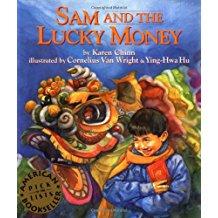
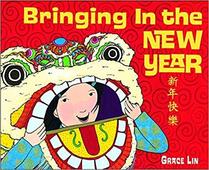
Grace Lin’s Chinese New Year book was one of the first to introduce young children to Chinese New Year with an informational text. This book is set in the USA and is very approachable for our younger readers. The text is simple and easy to read, the illustrations classic Lin, childlike with bright colors and all the right minimal details illustrating the facts being discussed. The excitement can be felt throughout the house as the family prepares for the New Year. Lin emphasizes the many parts of the holiday incorporating her own family experiences. In the back matter, Lin gives additional information to explain the different customs and traditions.
In 2013, a board book edition of Bringing in the New Year was published. The format is a bit different than the original. The story is the same, but it is divided into Four Chapters. In each chapter there are purple insets giving a few explanatory facts about the topic of the chapter. It’s a though Lin took the back matter from her original book and organized into the four chapters with the original story. This book is well suited to the Chinese New Year we celebrate here in America. I find I like the board book edition is better to share with children. What is your opinion?
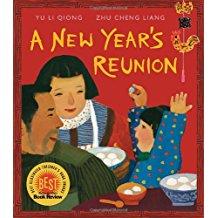
This is a quiet poignant story of the reality of a small child’s life in China. Chinese New Year for this family is just a few days of being together for the whole year. As I was preparing this list of books, this story stood out because of all the immigration/migration talk in our world today. This book takes place in China, where there are over 100 million migrant workers working hundreds or sometimes thousands of miles from home. But perhaps, this story could also happen anywhere in the world today because of parents’ work, migratory work conditions, and immigration laws, etc. have separated families. I think there is some valuable conversation that could come from reading this picture book to all ages.
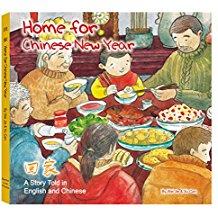
In this more recent book set in China, the father also works in the city far from home and gets home only for the Chinese New Year celebration. He, too, must travel many days by many forms of transportation - by train, bus, three-wheeled motorcycle, a ferry and the last few miles on foot in snow up to his knees. I love the illustrations in this book! The double-paged spread of the train station packed with people is unlike anything we experience here, even in our most crowded cities! It is definitely China where its millions of people make this pilgrimage home to their families for the New Year. Both the author and illustrator are Chinese and I feel this makes the book feel very authentic. The sparse text is written in both English and Chinese. Most of the illustrations are done in soft watercolor hues. The illustrator adds several small pictures within the page illustrations to highlight and give chronology to the events being narrated, in a graphic novel style.
This book could easily be paired with Maomao’s story in New Year Reunion. In this book, however, Jiajun is a somewhat older child, and has a cell phone to keep track of his father’s journey! And he does! Small gray small sketches off to the side and bottom of the pages accompany the text of his conversations with his father, “Daddy, did you cross the Yangtze River yet?”; “Daddy, Grandma has made you chicken soup. Grandpa said you would arrive at noon.”; “Daddy, where are you? Mom and I have been waiting for you on the street.” ;“Daddy, Mom asked you to stay at my aunt’s house tonight. The weather forecast calls for less snow tomorrow!”
Another delightful piece of this story is the connection between the father and his son. It’s clear how devoted the father is, and also how well he knows his son. Throughout his journey he seems to be missing things from his pack, an apple, his water bottle and then he looses his scarf. But each time, even though his realizes he is missing something, he reaches down in his coat pocket again, and then pulls his hand out with relief. It’s clear he has something special in his pocket.
He doesn’t stay at the aunt’s house as his wife advises, but trudges on through in the dark with fierce snow and wind. It is New Year’s Eve, and he wants to get home for New Year’s Day. He is exhausted, but he makes it! The first thing he does is reach into his pocket and pulls out a green watch for Jiajun! They go and set off firecrackers together, and return in time for the family’s New Year’s Eve dinner! The rest of their time together is cleaning up the house, putting red couplets on their door and making snowmen together. "Jiajun was with his father every day.” One day he and his father were making lanterns for the Lantern Festival. Jiajun knows then that it is soon time to say goodbye. The next day, Jiajun hands his father a bag as he prepares to go. "Daddy, this is from me. Please don’t loose it. I’m letting you use my green scarf.” And in the corner of the page is an illustration of a plastic bag with an apple, a water bottle, and the green scarf. Jianun’s father says goodbye to his family and heads to the waiting bus for his journey back to the city.
There are many ways to compare and contrast this story with Maomao’s reunion story… If you choose to do so, please share out what you and your students come up with in the Forum Comments section. I’m not going to put my ideas here – they may limit you! I will share after some of you do, however.
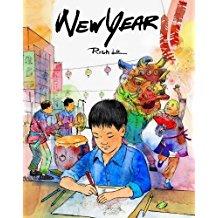
Right from the cover, this book has the flair of a contemporary story, and it is.
It’s a story of a Chinese family newly immigrated from Hong Kong. As you turn the title page, the dedication becomes part of the story, “Dedicated to my parents, who kept the family together through rough times in a country and culture they knew very little about.”
“I’ve barely slept.” It’s the first day of school and the action begins with the family all starting off to school in their new home of Los Angeles. The children are referred to as Number 4 brother, Number 3 sister, etc. very typical in China. We never find out the protagonist’s number spot in the family, however. He is uncomfortable as he meets his new class, and notices a Chinese girl whom the teacher asks to sit next to him. He understands nothing, until the Chinese girl explains that it is time for art, a subject he likes. He paints a scene from the Hong Kong harbor from his memory, but when all the children display their pictures, and they are all trees, he’s embarrassed, and a bit annoyed. “Why didn’t you tell me that the assignment was to draw a tree?” he asks the Chinese girl, who looks annoyed. Bright pen and ink and water-colored pictures move the story along. At first, our protagonist doesn’t feel good about being Chinese in America. His mother tries to reassure him and says someday he will be proud of being Chinese. I think this book would open discussion for ELL students in our classrooms – how do they feel? Over time, English becomes easier to understand and when the assignment is given to draw some pictures for their New Year celebration, our protagonist knows just what to do! When he shows his teacher the drawings the next day, he understands that she wants to use his drawings to make paper cutouts and painting for the class celebration! As they decorate the classroom for their New Year celebration, everyone is interested in his family! He tells them in broken English what the significance of the firecrackers, the paper lanterns, and of the lion and dragon dances. His Chinese friend shares how her family celebrates Chinese New Year at home, showing how proud she is of her heritage. After school, their teacher tells the two of them that she came to America from Mexico, and she didn’t speak any English either. Her family invited American neighbors to their home and shared their culture, making friends as she did. When the story ends, our new American says, “And I’m happy to be who I am.”
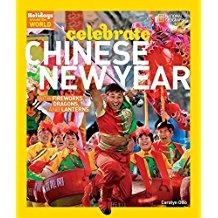
Of all the informational picture books on celebrating Chinese New Year, I like this one the best. Having National Geographic photographs add the excitement and authenticity in how the holiday is celebrated. The format is simple and easy to follow without be overwhelming in text or photographs. It gives good background information for the picture books discussed here. Topics like travel to be with families, what happened when Asians immigrated to other countries, what happens before the festival begins, the activities that happen during the festivities, letting the old year out, paying respect to the oldest members of families, parades, dancing with the dragons, and fireworks! Back matter includes Resources like MORE ABOUT CHINESE NEW YEAR, Facts, How to Make a Chinese Lantern, A Fortune Cookie Recipe, Games, The Chinese Calendar and Zodiac, and a GLOSSARY. There is also a WORLD MAP showing the locations of where the photos were taken from.
I also found this website about Celebrating Chinese New Year Around the World.
If you celebrate, Gung Hay Fat Choy!
Enjoy!

